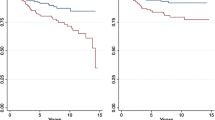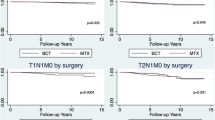Abstract
Purpose
Our aim was to describe variations in the treatment of early-stage breast cancer and to examine factors associated with disease-specific survival (DSS).
Methods
The study used linked data for 24,190 women with a T1 (≤ 20 mm) breast cancer who underwent surgery from 2005 to 2019. Multivariate logistic regression was used to model predictors of receiving breast-conserving surgery (BCS) compared to mastectomy and a multinomial model was used to examine factors associated with type(s) of treatment received.
Results
Overall, 70.3% had BCS, with a reduced likelihood of BCS observed for younger women (p < 0.001), rural residence, (p < 0.001), socioeconomic disadvantage (p = 0.004), higher tumour grade (p < 0.001) and surgery in a public versus private hospital (p < 0.001). Compared to women who received BCS and radiation therapy (RT), those having mastectomy alone or mastectomy plus RT were more likely to be younger (p < 0.001), live in a rural area (p < 0.001), have higher-grade tumours (p < 0.001) and positive lymph nodes (p < 0.001). Overall 5-year survival was 95.3% and breast cancer-specific survival was 98.3%. Highest survival was observed for women having BCS and RT and lowest for those having mastectomy and RT (p < 0.001).
Conclusion
Our results indicate some variation in the management of early-stage breast cancer. Lower rates of BCS were observed for rural and disadvantaged women and for those treated in a public or low-volume hospital. Whilst survival was high for this cohort, differences in tumour biology likely explain the differences in survival according to treatment type.


Similar content being viewed by others
Data availability
The datasets generated during and/or analysed during the current study are not publicly available due to confidentiality but are available from the corresponding author on reasonable request.
References
International Agency for Research on Cancer (IARC) Globocan: Cancer Today 2018. https://gco.iarc.fr/today/home. Accessed 24 Mar 2021
Lichter AS, Lippman ME, Danforth DN Jr, d’Angelo T, Steinberg SM, deMoss E et al (1992) Mastectomy versus breast-conserving therapy in the treatment of stage I and II carcinoma of the breast: a randomized trial at the National Cancer Institute. J Clin Oncol 10:976–983. https://doi.org/10.1200/JCO.1992.10.6.976
van Dongen JA, Voogd AC, Fentiman IS, Legrand C, Sylvester RJ, Tong D et al (2000) Long-term results of a randomized trial comparing breast-conserving therapy with mastectomy: European organization for research and treatment of cancer 10801 trial. J Natl Cancer Inst 92:1143–1150. https://doi.org/10.1093/jnci/92.14.1143
Veronesi U, Cascinelli N, Mariani L, Greco M, Saccozzi R, Luini A et al (2002) Twenty-year follow-up of a randomized study comparing breast-conserving surgery with radical mastectomy for early breast cancer. N Engl J Med 347:1227–1232. https://doi.org/10.1056/NEJMoa020989
Clarke M, Collins R, Darby S, Davies C, Elphinstone P, Evans V, Early Breast Cancer Trialistis’ Collaborative G et al (2005) Effects of radiotherapy and of differences in the extent of surgery for early breast cancer on local recurrence and 15-year survival: an overview of the randomised trials. Lancet 366:2087–2106. https://doi.org/10.1016/S0140-6736(05)67887-7
Cancer Australia (2020) Guidance for the management of early breast cancer: Recommendations and practice points, Cancer Australia, Surry Hills, NSW. https://www.guidancebreastcancer.gov.au/. Accessed 27 April 2021
National Institute for Health and Clinical Excellence Early and Locally Advanced Breast Cancer: Diagnosis and Treatment (Clinical Guideline 80). London: NICE (2009). Accessed 27 April 2021
New Zealand Guidelines Group (2009) Management of early breast cancer. Wellington: New Zealand Guidelines Group. https://www.health.govt.nz/publication/management-early-breast-cancer-evidence-based-best-practice-guideline. Accessed 27 April 2021
Cardoso F, Kyriakides S, Ohno S, Penault-Llorca F, Poortmans P, Rubio IT et al (2019) Early breast cancer: ESMO clinical practice guidelines for diagnosis, treatment and follow-up. Ann Oncol 30:1674. https://doi.org/10.1093/annonc/mdz189
Bellavance EC, Kesmodel SB (2016) Decision-making in the surgical treatment of breast cancer: factors influencing women’s choices for mastectomy and breast conserving surgery. Front Oncol 6:74. https://doi.org/10.3389/fonc.2016.00074
Engel J, Kerr J, Schlesinger-Raab A, Sauer H, Holzel D (2004) Quality of life following breast-conserving therapy or mastectomy: results of a 5-year prospective study. Breast J 10:223–231. https://doi.org/10.1111/j.1075-122X.2004.21323.x
Han J, Grothuesmann D, Neises M, Hille U, Hillemanns P (2010) Quality of life and satisfaction after breast cancer operation. Arch Gynecol Obstet 282:75–82. https://doi.org/10.1007/s00404-009-1302-y
Mitchell KJ, Fritschi L, Reid A, McEvoy SP, Ingram DM, Jamrozik K et al (2006) Rural-urban differences in the presentation, management and survival of breast cancer in Western Australia. Breast 15:769–776. https://doi.org/10.1016/j.breast.2006.04.001
Azzopardi J, Walsh D, Chong C, Taylor C (2014) Impact of geographic location on surgical outcomes of women with breast cancer. ANZ J Surg 84:735–739. https://doi.org/10.1111/ans.12514
Fisher S, Gao H, Yasui Y, Dabbs K, Winget M (2015) Treatment variation in patients diagnosed with early stage breast cancer in Alberta from 2002 to 2010: a population-based study. BMC Health Serv Res 15:35. https://doi.org/10.1186/s12913-015-0680-z
Baade PD, Dasgupta P, Youl PH, Pyke C, Aitken JF (2016) Geographical inequalities in surgical treatment for localized female breast cancer, Queensland, Australia 1997–2011: improvements over time but inequalities remain. Int J Environ Res Public Health. https://doi.org/10.3390/ijerph13070729
McGuire KP, Santillan AA, Kaur P, Meade T, Parbhoo J, Mathias M et al (2009) Are mastectomies on the rise? A 13-year trend analysis of the selection of mastectomy versus breast conservation therapy in 5865 patients. Ann Surg Oncol 16:2682–2690. https://doi.org/10.1245/s10434-009-0635-x
Albornoz CR, Matros E, Lee CN, Hudis CA, Pusic AL, Elkin E et al (2015) Bilateral mastectomy versus breast-conserving surgery for early-stage breast cancer: the role of breast reconstruction. Plast Reconstr Surg 135:1518–1526. https://doi.org/10.1097/PRS.0000000000001276
Australian Bureau of Statistics Australian Statistical Geography Standard (ASGS): Volume 5—Remoteness Structure 2011. Canberra: ABS 2013. Accessed 27 April 2021
Australian Bureau of Statistics Census of Population and Housing: Socio-Economic Indexes for Areas (SEIFA), Australia, 2011. Canberra: ABS. http://www.abs.gov.au/ausstats/abs@.nsf/Lookup/by%20Subject/2033.0.55.001~2011~Main%20Features~Main%20Page~1. Accessed 27 April 2021
van Steenbergen LN, van de Poll-Franse LV, Wouters MW, Jansen-Landheer ML, Coebergh JW, Struikmans H et al (2010) Variation in management of early breast cancer in the Netherlands, 2003–2006. Eur J Surg Oncol 36(Suppl 1):S36-43. https://doi.org/10.1016/j.ejso.2010.06.021
Collins IM, Lum C, Versace VL (2018) Influence of socioeconomic factors and distance to radiotherapy on breast-conserving surgery rates for early breast cancer in regional Australia; implications of change. Asia Pac J Clin Oncol 14:e224–e230. https://doi.org/10.1111/ajco.12828
Bargallo-Rocha JE, Torres-Dominguez JA, Reynoso-Noveron N, Rivera-Corona J, Ramirez-Ugalde MT, Robles-Vidal CD et al (2021) Trends in breast-conserving surgery in Mexico after the implementation of a public health insurance system. Eur J Surg Oncol. https://doi.org/10.1016/j.ejso.2021.03.003
Pendlebury SC, Ivanov O, Renwick S, Stevens GN (2003) Long-term review of a breast conservation series and patterns of care over 18 years. ANZ J Surg 73:577–583. https://doi.org/10.1046/j.1445-2197.2003.t01-1-02704.x
Zhou P, Gautam S, Recht A (2007) Factors affecting outcome for young women with early stage invasive breast cancer treated with breast-conserving therapy. Breast Cancer Res Treat 101:51–57. https://doi.org/10.1007/s10549-006-9268-y
Wang J, Boult M, Tyson S, Babidge W, Zorbas H, Kollias J et al (2008) Trends in surgical treatment of younger patients with breast cancer in Australia and New Zealand. ANZ J Surg 78:665–669. https://doi.org/10.1111/j.1445-2197.2008.04613.x
Azzopardi J, Walsh D, Chong C, Taylor C (2014) Surgical treatment for women with breast cancer in relation to socioeconomic and insurance status. Breast J 20:3–8. https://doi.org/10.1111/tbj.12203
Celaya MO, Rees JR, Gibson JJ, Riddle BL, Greenberg ER (2006) Travel distance and season of diagnosis affect treatment choices for women with early-stage breast cancer in a predominantly rural population (United States). Cancer Causes Control 17:851–856. https://doi.org/10.1007/s10552-006-0025-7
Youl P, Morris B, Jenny A, Morstyn L (2019) What factors influence the treatment decisions of women with breast cancer? Does residential location play a role? Rural Remote Health 19:4497. https://doi.org/10.22605/RRH4497
Shearer R, Rashid M, Hubbard G, Abbott N, Daltrey I, Mullen R (2016) Factors associated with patients in the Scottish Highlands who chose mastectomy when suitable for breast conservation. Gland Surg 5:385–390. https://doi.org/10.21037/gs.2016.03.02
Darby SC, Ewertz M, McGale P, Bennet AM, Blom-Goldman U, Bronnum D et al (2013) Risk of ischemic heart disease in women after radiotherapy for breast cancer. N Engl J Med 368:987–998. https://doi.org/10.1056/NEJMoa1209825
Peltoniemi P, Peltola M, Hakulinen T, Hakkinen U, Pylkkanen L, Holli K (2011) The effect of hospital volume on the outcome of breast cancer surgery. Ann Surg Oncol 18:1684–1690. https://doi.org/10.1245/s10434-010-1514-1
Vrijens F, Stordeur S, Beirens K, Devriese S, Van Eycken E, Vlayen J (2012) Effect of hospital volume on processes of care and 5-year survival after breast cancer: a population-based study on 25000 women. Breast 21:261–266. https://doi.org/10.1016/j.breast.2011.12.002
Allgood PC, Bachmann MO (2006) Effects of specialisation on treatment and outcomes in screen-detected breast cancers in Wales: cohort study. Br J Cancer 94:36–42. https://doi.org/10.1038/sj.bjc.6602894
Reitsamer R, Menzel C, Glueck S, Hitzl W, Peintinger F (2008) Predictors of mastectomy in a certified breast center—the surgeon is an independent risk factor. Breast J 14:324–329. https://doi.org/10.1111/j.1524-4741.2008.00592.x
Horst KC, Smitt MC, Goffinet DR, Carlson RW (2005) Predictors of local recurrence after breast-conservation therapy. Clin Breast Cancer 5:425–438. https://doi.org/10.3816/cbc.2005.n.001
van Dooijeweert C, Baas IO, Deckers IAG, Siesling S, van Diest PJ, van der Wall E (2021) The increasing importance of histologic grading in tailoring adjuvant systemic therapy in 30,843 breast cancer patients. Breast Cancer Res Treat 187:577–586. https://doi.org/10.1007/s10549-021-06098-7
Rakha EA, El-Sayed ME, Lee AH, Elston CW, Grainge MJ, Hodi Z et al (2008) Prognostic significance of Nottingham histologic grade in invasive breast carcinoma. J Clin Oncol 26:3153–3158. https://doi.org/10.1200/JCO.2007.15.5986
Agarwal S, Pappas L, Neumayer L, Kokeny K, Agarwal J (2014) Effect of breast conservation therapy vs mastectomy on disease-specific survival for early-stage breast cancer. JAMA Surg 149:267–274. https://doi.org/10.1001/jamasurg.2013.3049
Hartmann-Johnsen OJ, Karesen R, Schlichting E, Nygard JF (2015) Survival is better after breast conserving therapy than mastectomy for early stage breast cancer: a registry-based follow-up study of Norwegian women primary operated between 1998 and 2008. Ann Surg Oncol 22:3836–3845. https://doi.org/10.1245/s10434-015-4441-3
Hwang ES, Lichtensztajn DY, Gomez SL, Fowble B, Clarke CA (2013) Survival after lumpectomy and mastectomy for early stage invasive breast cancer: the effect of age and hormone receptor status. Cancer 119:1402–1411. https://doi.org/10.1002/cncr.27795
Acknowledgements
The authors wish to thank members of The Partnership and Cancer Alliance Queensland for their valuable contributions to the management of cancer in Queensland. The authors also thank the Queensland Cancer Control Analysis Team who maintain the Queensland Oncology Repository, including John Harrington and Danica Cossio.
Funding
The authors declare no funds, grants, or other support were received during the preparation of this manuscript.
Author information
Authors and Affiliations
Contributions
PY, SP, JM and DT contributed to concept and design, JM and PY contributed to data collection, PY, SP, JM, MM and DT contributed to analysis and interpretation of data, PY, SP, JM, MM and DT contributed to manuscript writing and approval.
Corresponding author
Ethics declarations
Conflict of interest
The authors have no relevant financial or non-financial interests to disclose.
Ethical approval
This study was conducted under the auspices of Cancer Alliance Queensland’s ‘The Partnership’, a gazetted quality assurance committee under section 82 of the Hospital and Health Boards Act (2011). This legislation allows The Partnership to access identifiable information to fulfil its functions, including undertaking clinical research.
Additional information
Publisher's Note
Springer Nature remains neutral with regard to jurisdictional claims in published maps and institutional affiliations.
Rights and permissions
About this article
Cite this article
Youl, P., Philpot, S., Moore, J. et al. Trends in surgery and adjuvant treatment for early-stage breast cancer: a population-based study in Queensland, Australia. Breast Cancer Res Treat 193, 175–185 (2022). https://doi.org/10.1007/s10549-022-06551-1
Received:
Accepted:
Published:
Issue Date:
DOI: https://doi.org/10.1007/s10549-022-06551-1




